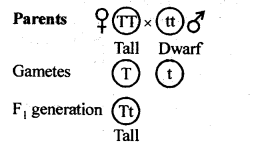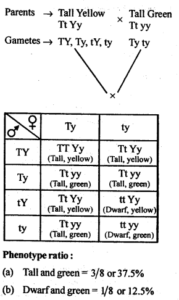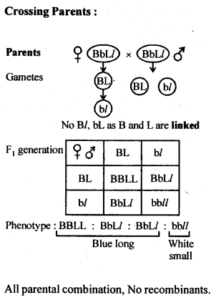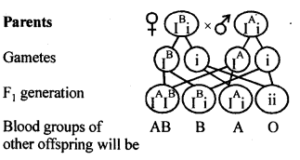Chapter 5: Principles of Inheritance and Variation Class 12 Biology NCERT Solutions
Master Mendel’s laws, chromosomal theory, and genetic disorders with detailed NCERT Solutions for Chapter 5. Download free PDFs for easy practice. Scroll down to find exam-ready, explained answers.
To Help You Excel: NCERT Solutions for Class 12 Biology Chapter 5 – Principles of Inheritance and Variation
Our expert-curated NCERT Solutions for Chapter 5 offer in-depth, accurate answers to all Intext and Exercise questions. These solutions simplify complex concepts using easy-to-understand explanations, diagrams, and examples, making them ideal for board and NEET aspirants.
What You Will Learn in Chapter 5 – Principles of Inheritance and Variation
This chapter builds the foundation of classical and molecular genetics. It explores how traits are transmitted from one generation to the next and how variations contribute to evolution and diversity in organisms.
Key Topics Covered:
1. Mendel’s Experiments and Laws of Inheritance
– Monohybrid and dihybrid crosses
– Law of dominance, segregation, and independent assortment
– Mendel’s success and statistical approach
2. Inheritance of One Gene and Two Genes
– Punnett square analysis
– Test cross and back cross
– Incomplete dominance and codominance
– Multiple alleles and ABO blood group inheritance
3. Chromosomal Theory of Inheritance
– Contributions of Sutton and Boveri
– Linkage and recombination in Drosophila
– Crossing over and gene mapping
4. Sex Determination
– XY system in humans, XO in insects, ZW in birds
– Role of chromosomes in determining sex
– Sex-linked inheritance (hemophilia, color blindness)
5. Genetic Disorders
– Mendelian disorders: Thalassemia, sickle-cell anemia, phenylketonuria
– Chromosomal disorders: Down’s syndrome, Turner’s syndrome, Klinefelter’s syndrome
– Pedigree analysis and genetic counseling
Why Use Our NCERT Solutions for Chapter 5?
This chapter can be concept-heavy and diagram-based. Our solutions are designed to break down genetic principles step by step, with Punnett squares, pedigree charts, and chromosome diagrams to help you visualize each concept clearly.
Highlights of Our Solutions:
– Comprehensive coverage of all NCERT Intext and Exercise questions
– Labeled illustrations for crosses, chromosomes, and genetic disorders
– Conceptual clarity using real-life genetic examples
– Emphasis on NEET-relevant content like Mendelian ratios and disorders
– Definitions and keywords highlighted for revision
NCERT Solutions for Chapter 5 – Principles of Inheritance and Variation
Intext Questions:
– Concept-based answers on Mendel’s experiments
– Understanding dominance, alleles, and genotype vs phenotype
– Diagrams for monohybrid and dihybrid crosses
Exercise Questions (Q.1 to Q.16):
– Solved numerical problems using Punnett squares
– Mendelian and chromosomal disorders with examples
– Pedigree charts and sex-linked inheritance explained
– Differences between incomplete dominance and codominance
Download Chapter 5 Solutions PDF – Principles of Inheritance and Variation
Study offline and revise anytime with our free, well-organized PDF. Ideal for quick board revisions and NEET preparation.
What’s Inside the PDF:
– Stepwise NCERT answers with labeled diagrams
– Tables and charts for key differences and disorders
– Aligned with CBSE and NEET syllabus
Recommended Preparation Tips:
– Practice drawing and analyzing Punnett squares
– Memorize Mendel’s laws and key genetic terms
– Revise sex determination systems across organisms
– Learn symptoms and causes of major genetic disorders
– Solve past NEET and board questions on inheritance and variation
Additional Study Resources:
– Class 12 Biology Notes – Chapter 5
– NCERT Exemplar Questions with Solutions
– Pedigree chart flashcards and practice sets
– Important NEET-based MCQs from previous years
– Summary tables for dominant vs recessive traits
Mastering Genetics Begins Here
Understanding how traits are inherited helps explain the diversity of life and the basis of many genetic conditions. With our detailed NCERT solutions, well-explained diagrams, and revision-ready summaries, you’ll gain a strong grasp of one of Biology’s most important chapters. Get ready to score high and think like a geneticist.
NCERT Solutions for Class 12 Biology Chapter 5 – Principles of Inheritance and Variation
Question 1:
Mention the advantages of selecting pea plant for experiment by Mendel.
Answer: Mendel selected the garden pea plant (Pisum sativum) for his experiments due to the following advantages:
- It is an annual plant with a short life span and gives results within 3 months.
- It is easy to grow and requires minimal care except during pollination.
- F1 hybrids are fertile.
- It has seven pairs of easily distinguishable contrasting traits.
- It shows true breeding due to self-pollination.
Question 2:
Differentiate between the following:
- Dominance and Recessive
Dominant alleles express their trait in the heterozygous condition, while recessive alleles remain unexpressed in such conditions. - Homozygous and Heterozygous
Homozygous individuals have identical alleles (e.g., TT or tt), whereas heterozygous individuals have different alleles (e.g., Tt). - Monohybrid and Dihybrid
A monohybrid cross considers one character (e.g., plant height), while a dihybrid cross considers two characters simultaneously (e.g., seed color and shape).
Question 3:
A diploid organism is heterozygous for 4 loci. How many types of gametes can be produced?
Answer: The number of gametes = 2⁴ = 16 types of gametes.
Question 4:
Explain the Law of Dominance using a monohybrid cross.
Answer:
According to the Law of Dominance, in a cross between two organisms with contrasting traits, only one trait (dominant) is expressed in the F1 generation. For example, crossing true-breeding tall (TT) with dwarf (tt) plants results in all tall (Tt) offspring in F1. This shows that tall (T) is dominant over dwarf (t).
Question 5:
Define and design a test-cross.
Answer: 
A test-cross is performed by crossing an individual with a dominant phenotype with a homozygous recessive individual to determine the genotype of the dominant parent. It helps to determine whether the individual is homozygous dominant or heterozygous.
Question 6:
Using a Punnett Square, work out the distribution of phenotypic features in the first filial generation after a cross between a homozygous female and a heterozygous male for a single locus.
Answer:
| T | t | |
|---|---|---|
| T | TT | Tt |
| T | TT | Tt |
Phenotype: All Tall
Genotype Ratio: TT : Tt = 2 : 2 or 1 : 1
Question 7:
When a cross is made between a tall plant with yellow seeds (TtYy) and a tall plant with green seeds (Ttyy), what proportions of phenotypes in the offspring could be expected to be:
- Tall and green
- Dwarf and green
Answer:
- Tall and green: 6 out of 16
- Dwarf and green: 2 out of 16
Question 8:
Two heterozygous parents are crossed. If the two loci are linked, what would be the distribution of phenotypic features in F1 generation for a dihybrid cross?
Answer: 
If the loci are linked, parental combinations will be more frequent in F1 generation. Recombinants will be fewer. The result will deviate from the classical 9:3:3:1 ratio seen in unlinked genes.
Question 9:
Briefly mention the contribution of T.H. Morgan in genetics.
Answer: T.H. Morgan is regarded as the “Father of Experimental Genetics”. He used fruit fly (Drosophila melanogaster) to discover linkage, crossing over, sex-linked inheritance, and gene mapping. He proved that genes are located on chromosomes and are arranged linearly. He also explained criss-cross inheritance and introduced the concept of centiMorgan (cM) as a map unit.
Question 10:
What is pedigree analysis? Suggest how such an analysis can be useful.
Answer: Pedigree analysis involves the study of inheritance patterns of traits over generations in a family. It helps in:
- Understanding inheritance patterns.
- Genetic counseling.
- Identifying whether a trait is dominant or recessive.
- Locating the origin of genetic disorders in a family or population.
Question 11:
How is sex determined in human beings?
Answer: Sex in humans is determined by the XY type of sex determination system. Females have XX chromosomes, and males have XY. The sperm determines the sex of the child. If it carries X, the child is female; if it carries Y, the child is male.
Question 12:
A child has blood group O. If the father has blood group A and mother has blood group B, work out the genotypes of the parents and the possible genotypes of the other offspring.
Answer: 
The child’s genotype is ii (O group), which means both parents must carry the i allele. So, father’s genotype is IAi and mother’s is IBi.
Possible offspring genotypes: IAIB (AB), IAi (A), IBi (B), ii (O)
Question 13:
Explain the following terms with examples:
- Co-dominance: When both alleles in a heterozygote are fully expressed. Example: Blood group AB (IAIB) where both A and B antigens are expressed.
- Incomplete dominance: When neither allele is completely dominant and the resulting phenotype is intermediate. Example: Crossing red and white Mirabilis jalapa results in pink flowers in F1.
Question 14:
What is point mutation? Give one example.
Answer: A point mutation is a change in a single base pair in DNA. Example: Sickle cell anaemia caused by a change from GAG to GTG in the beta-globin gene.
Question 15:
Who had proposed the chromosomal theory of inheritance?
Answer: The chromosomal theory of inheritance was proposed independently by Sutton and Boveri in 1902. It states that genes are located on chromosomes, and their segregation and independent assortment during meiosis explain Mendel’s laws.
Question 16:
Mention any two autosomal genetic disorders with their symptoms.
Answer:
- Sickle Cell Anaemia: Sickled red blood cells, poor oxygen transport, anemia, and pain.
- Phenylketonuria (PKU): Mental retardation, light skin and hair (hypopigmentation), and eczema due to the accumulation of phenylalanine.